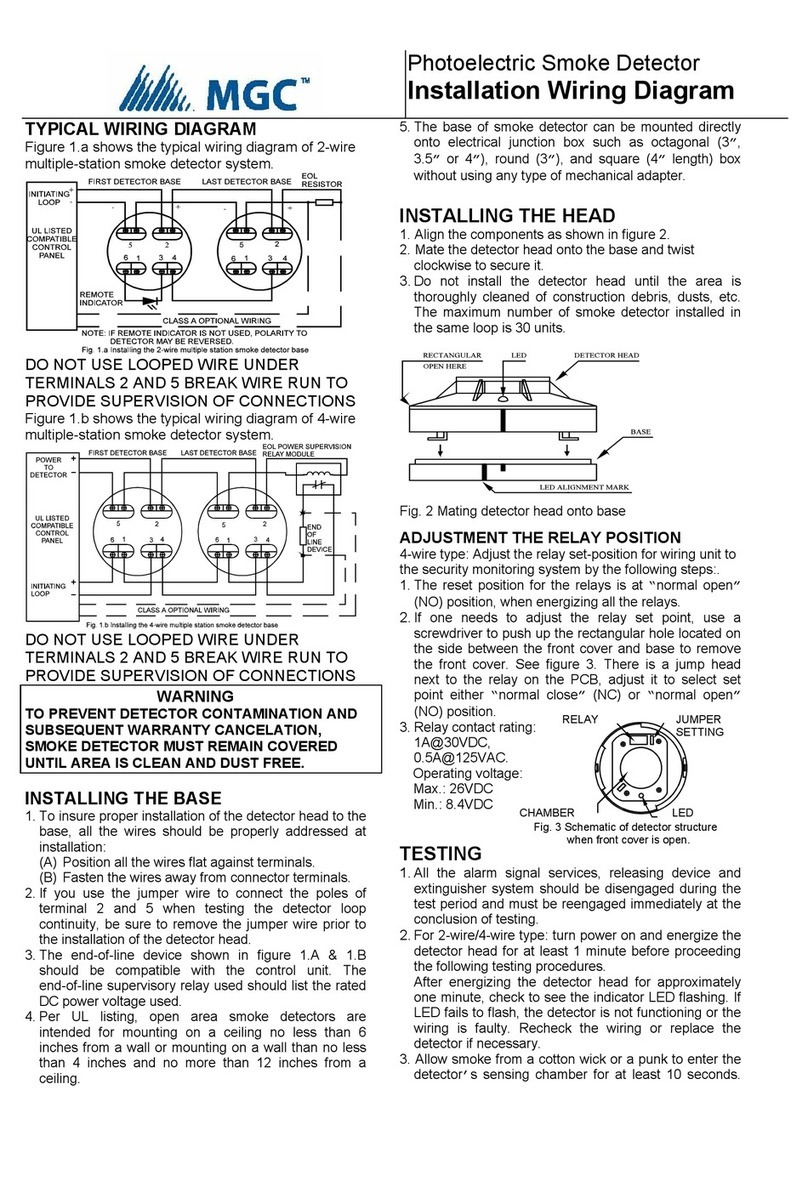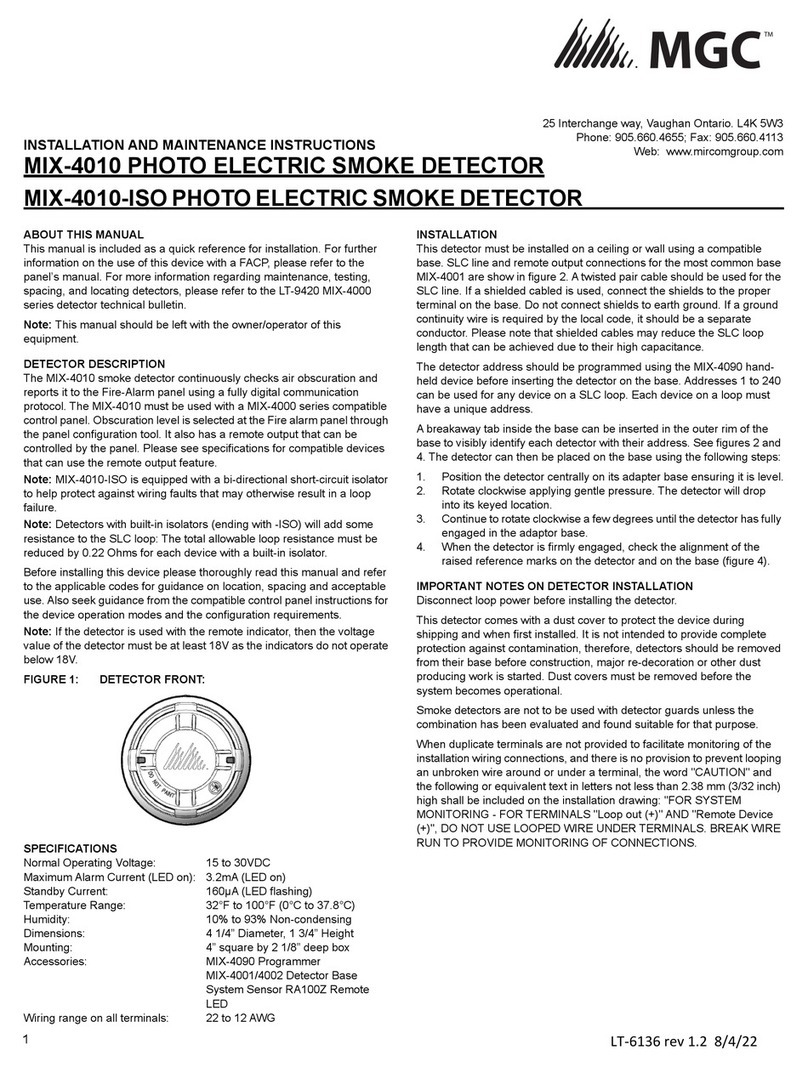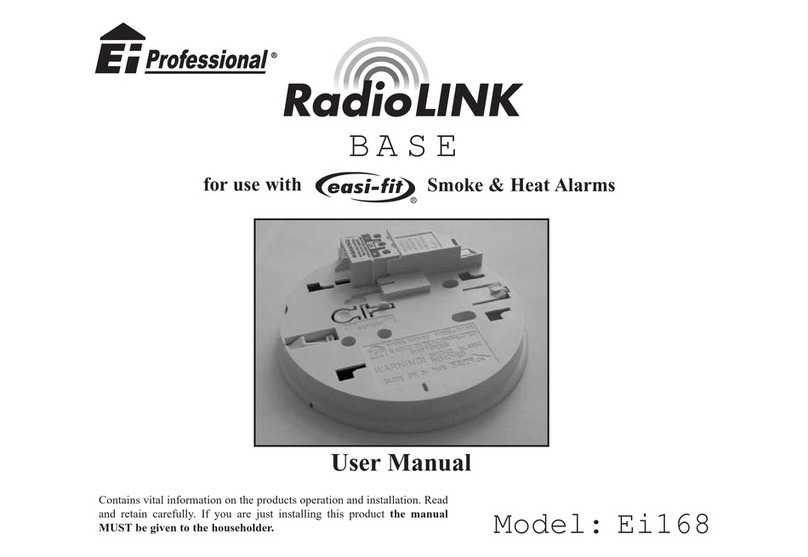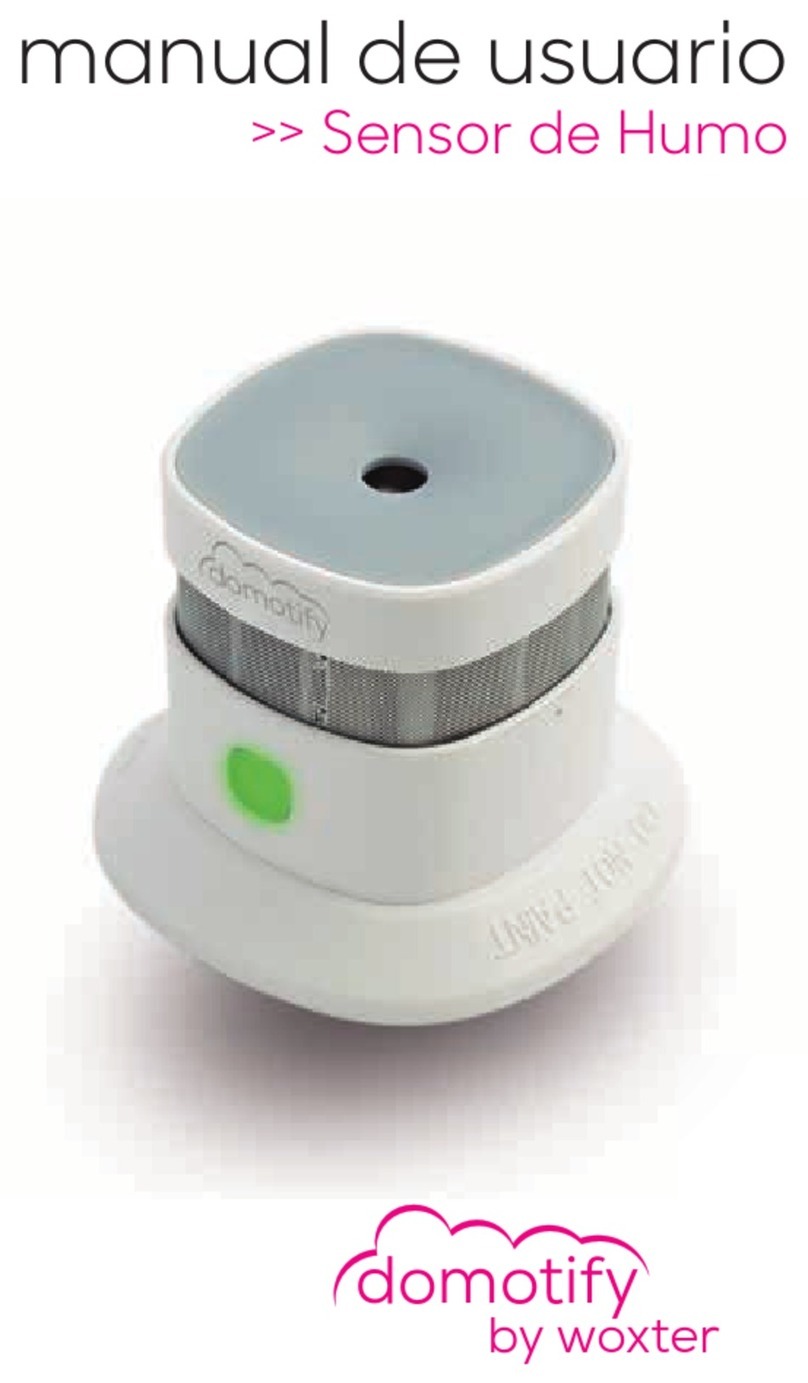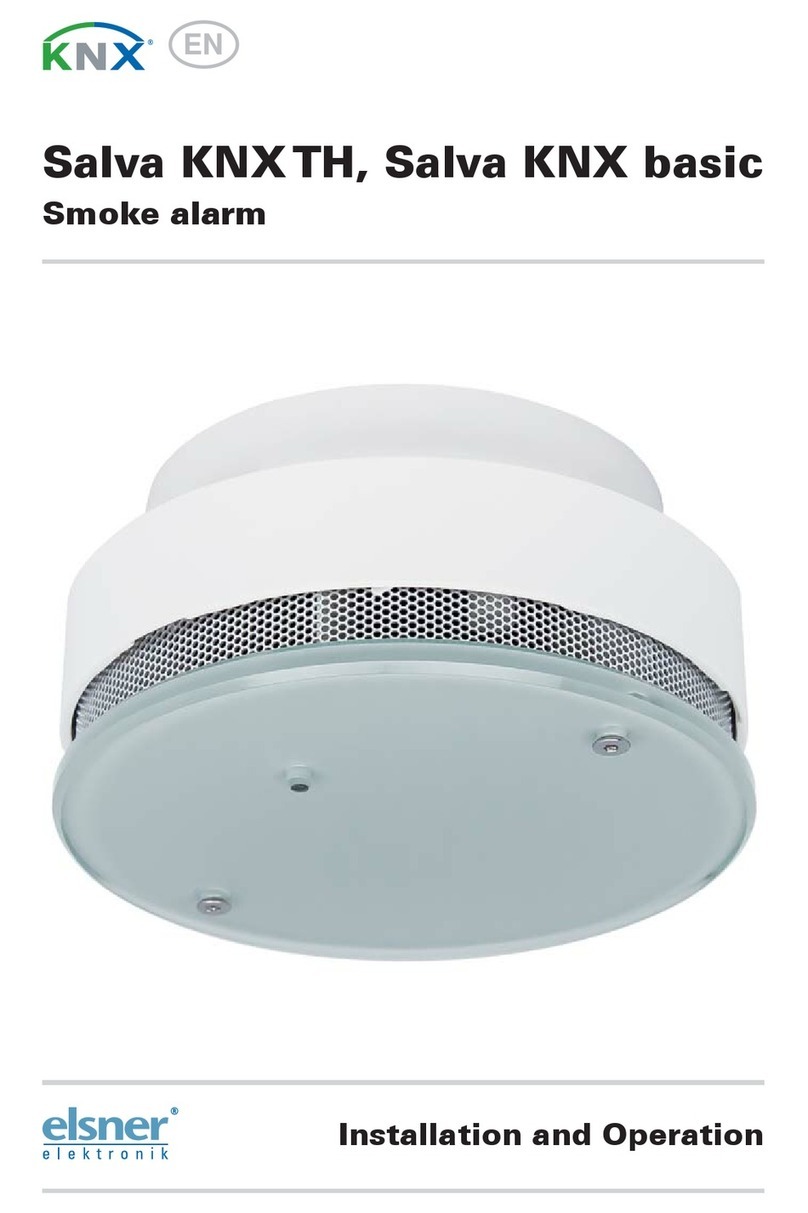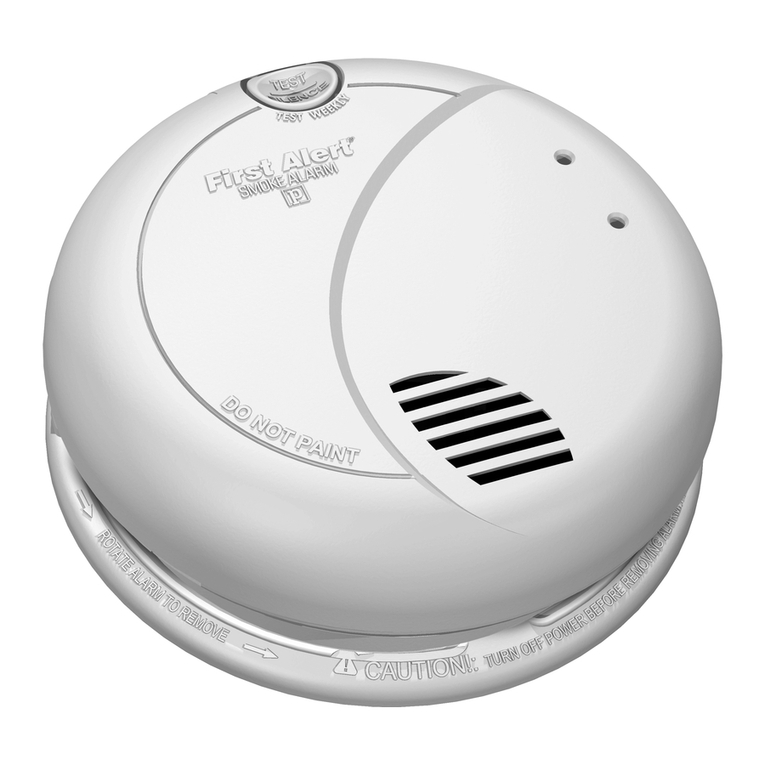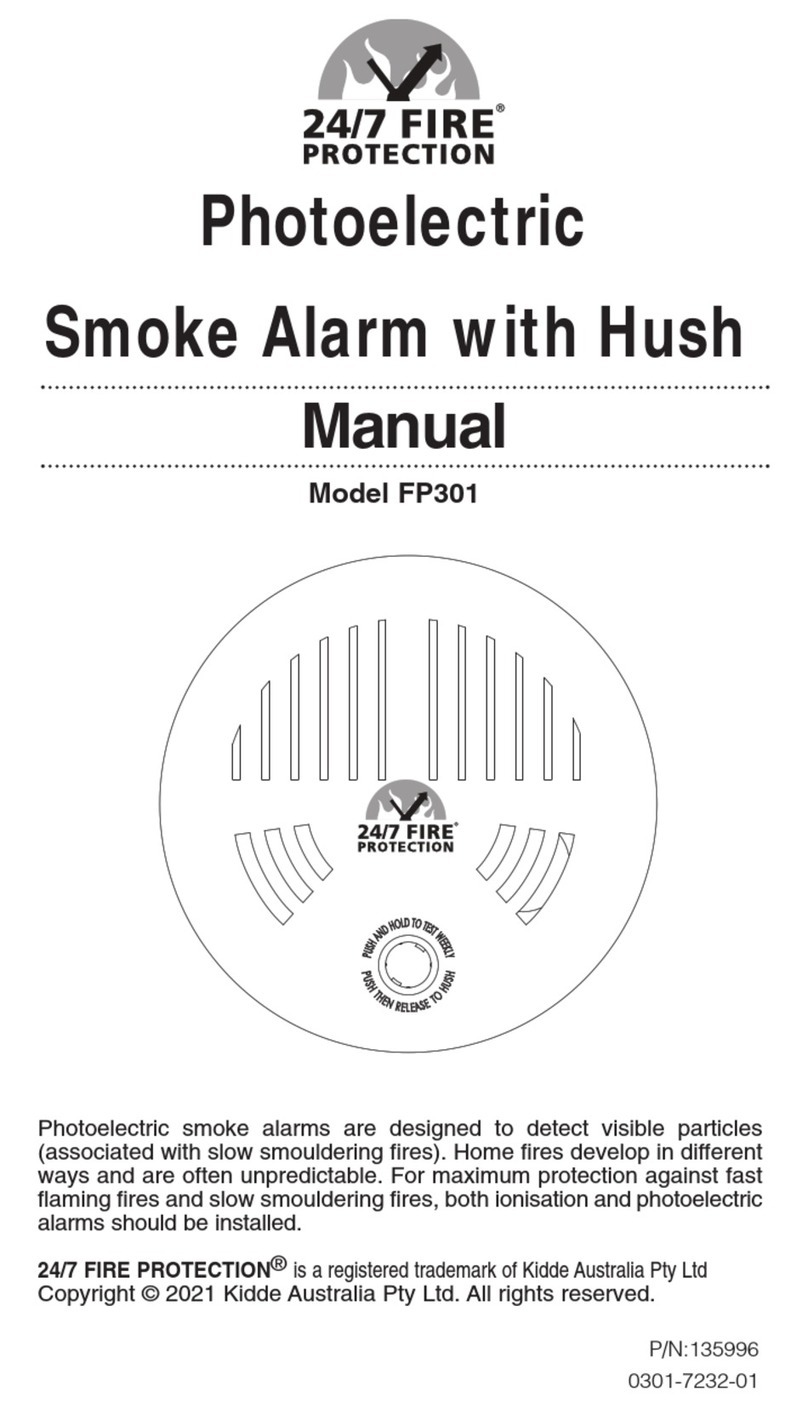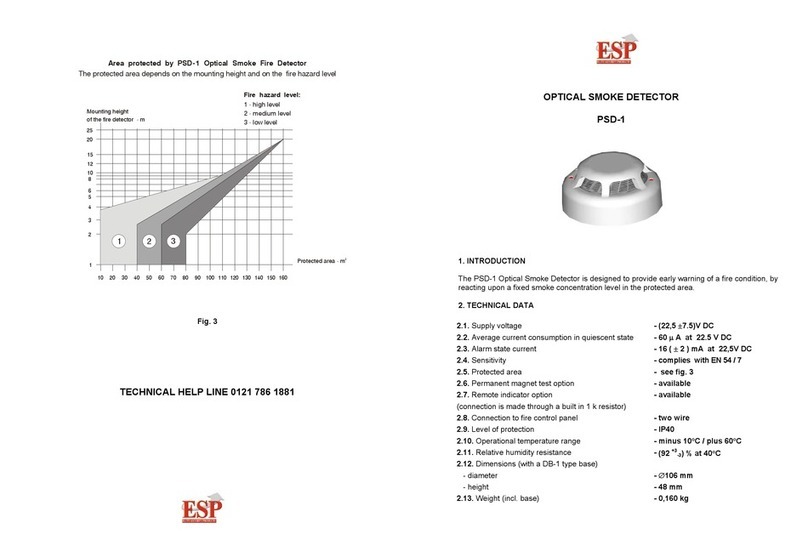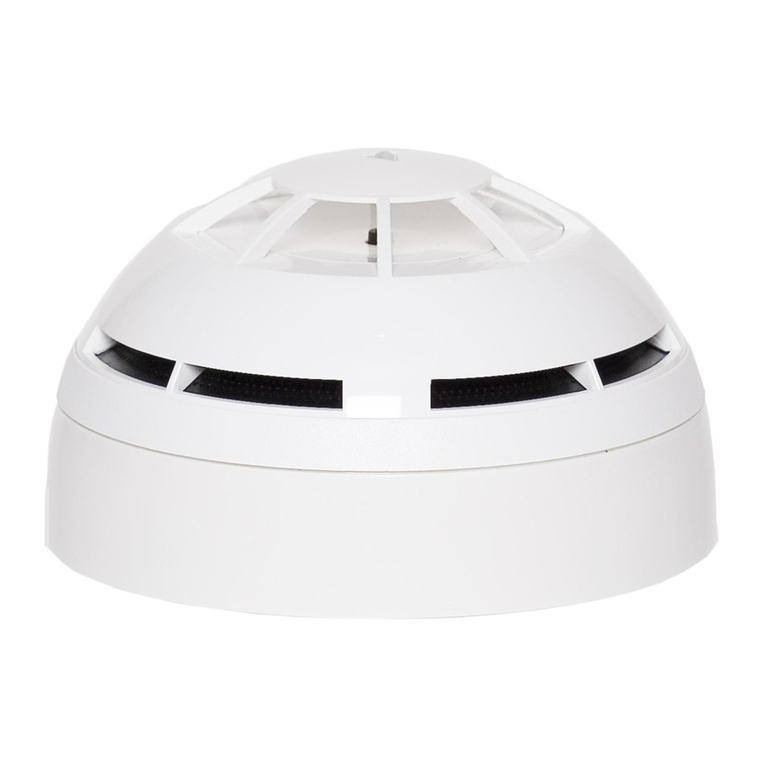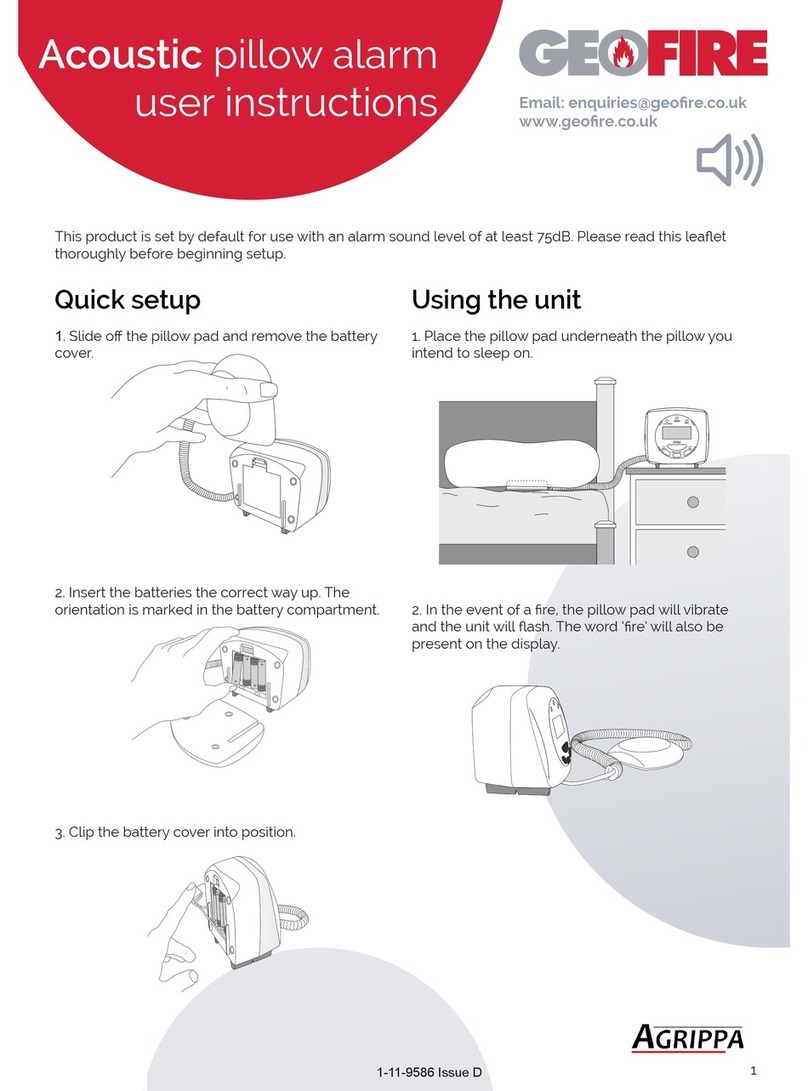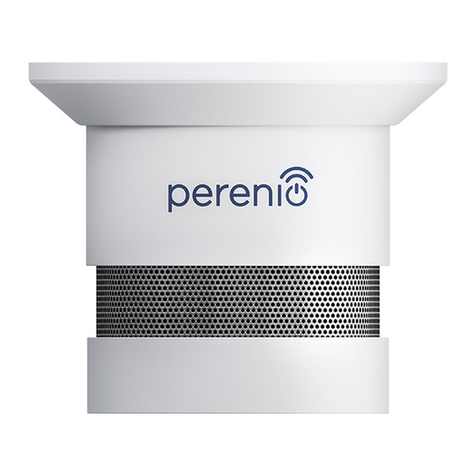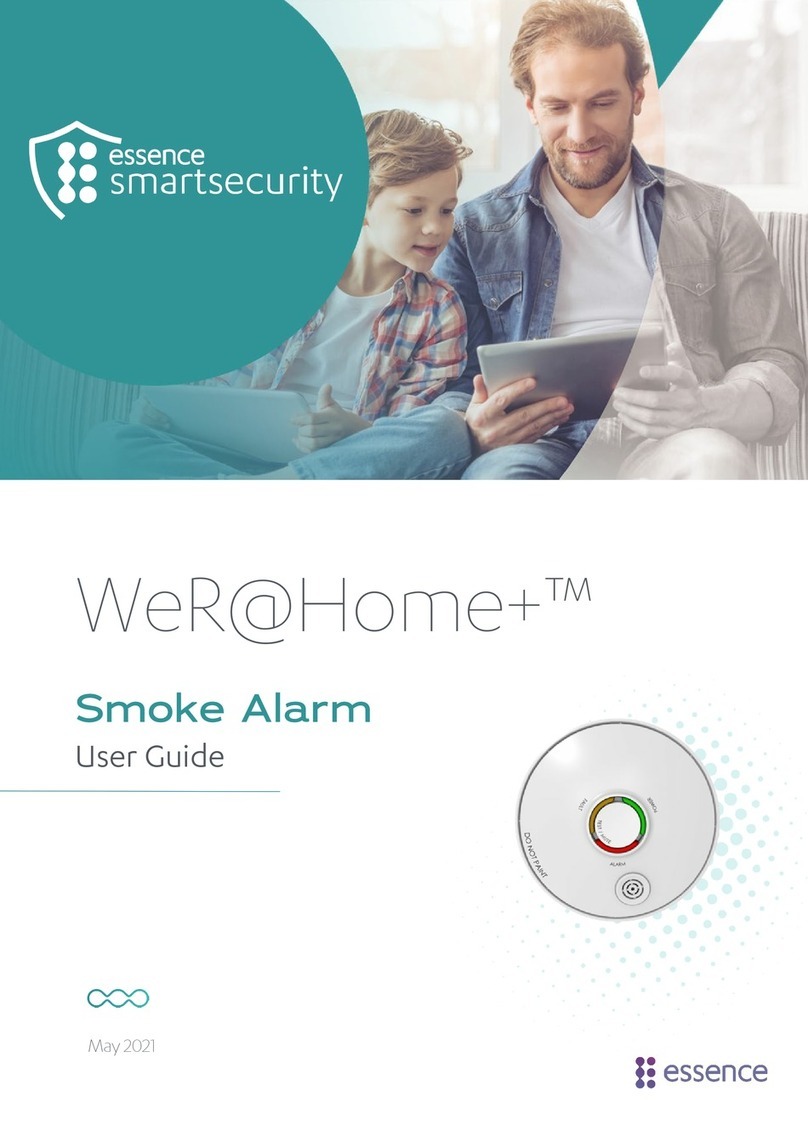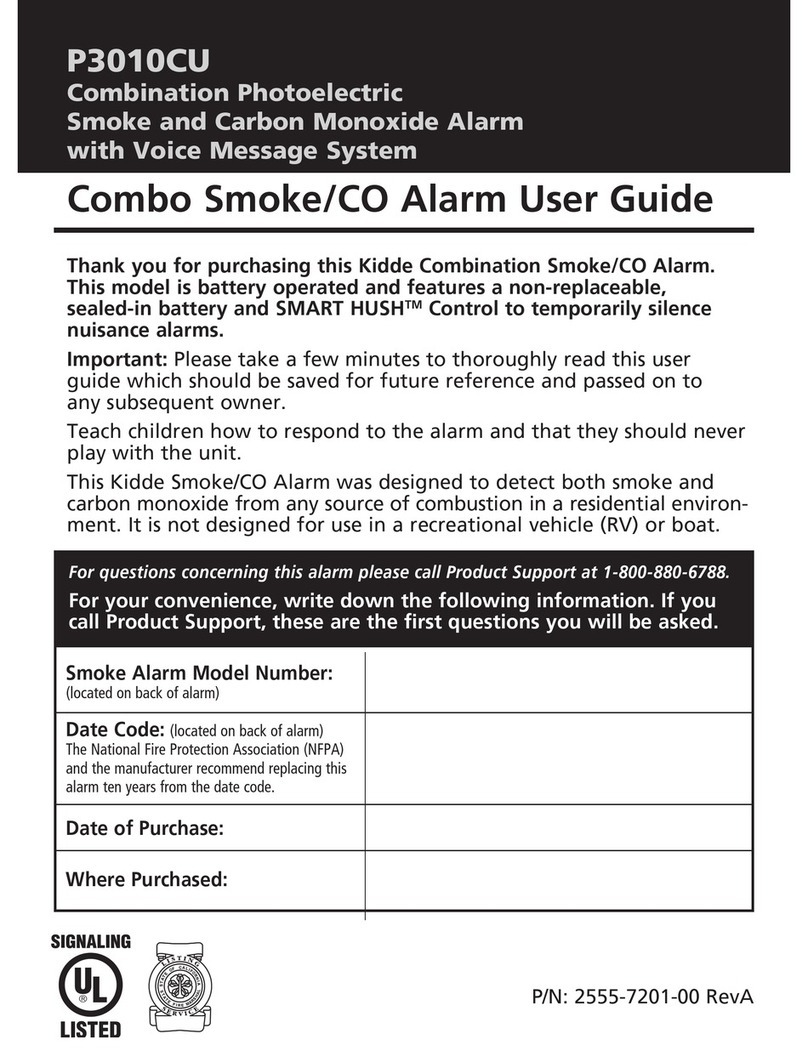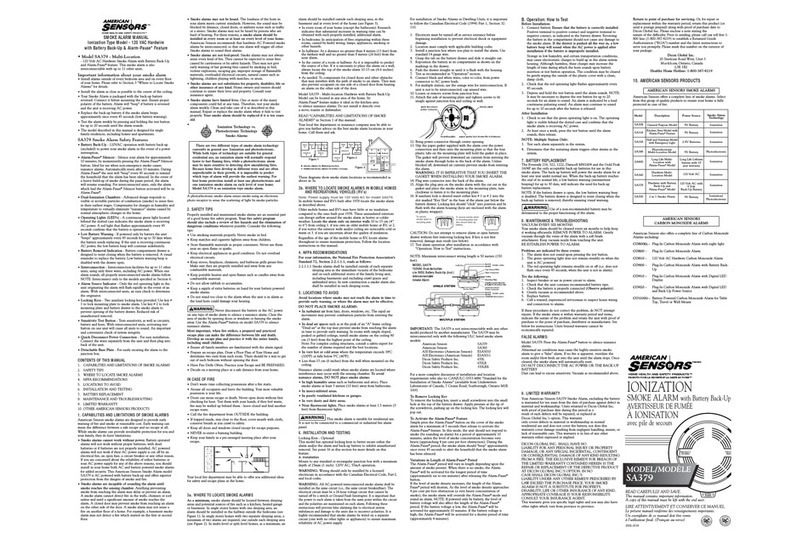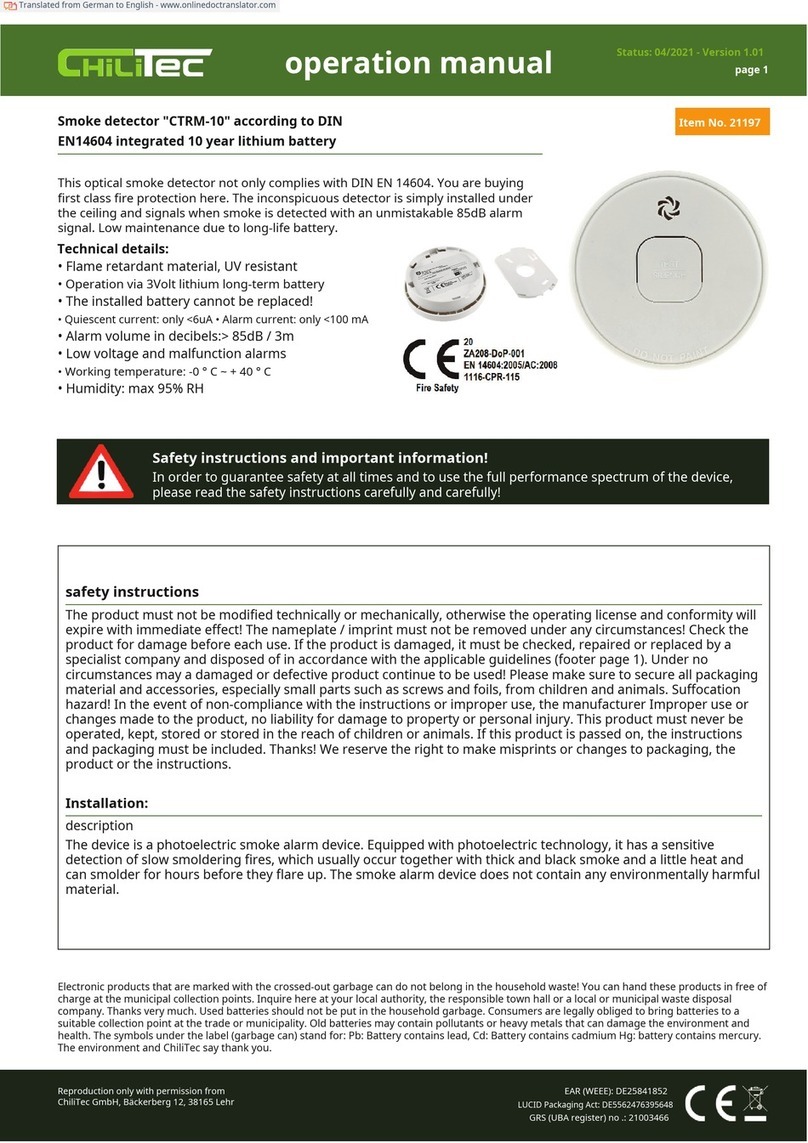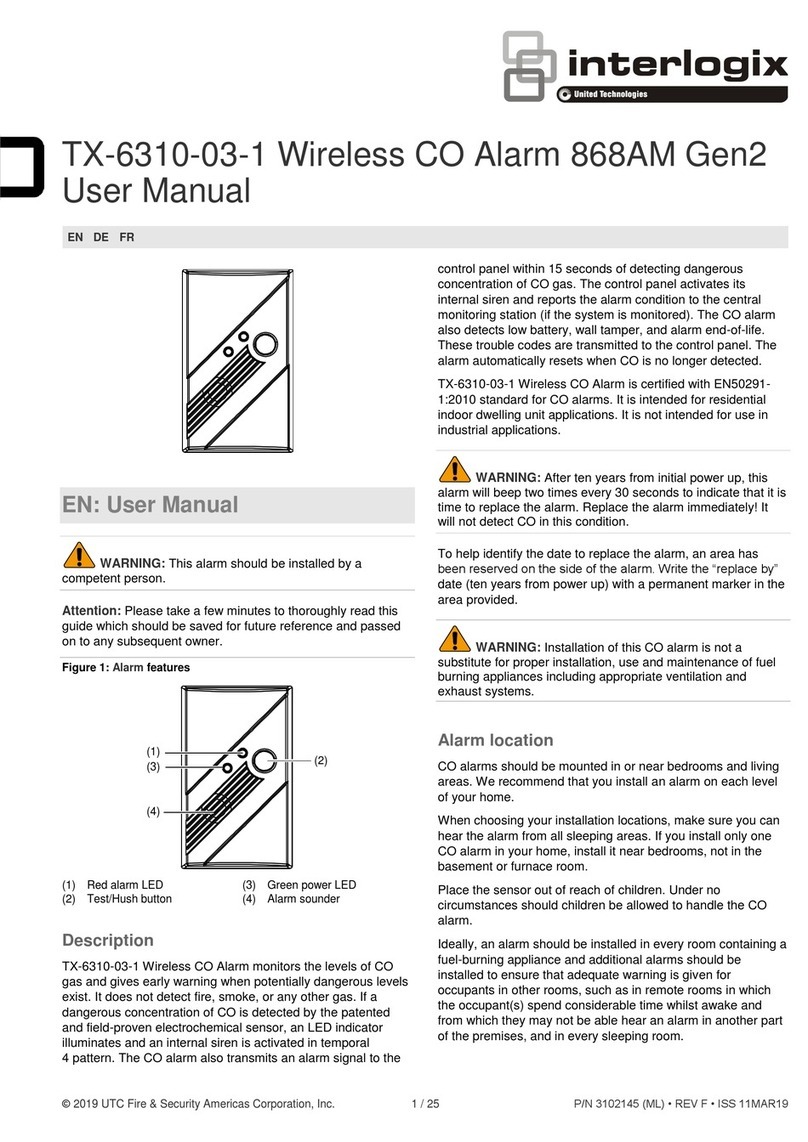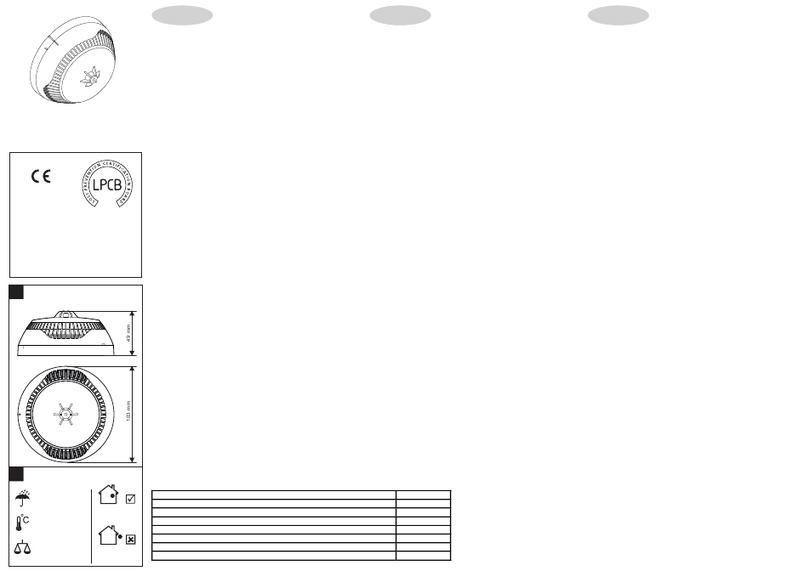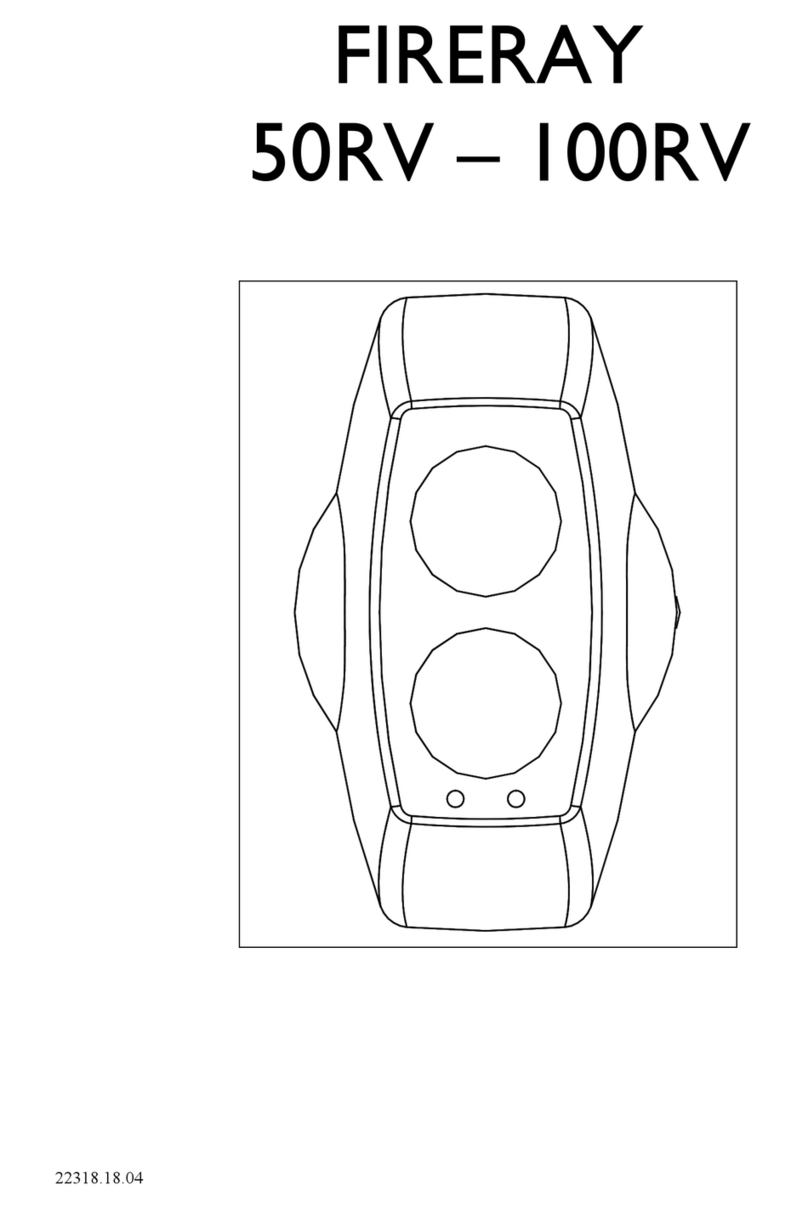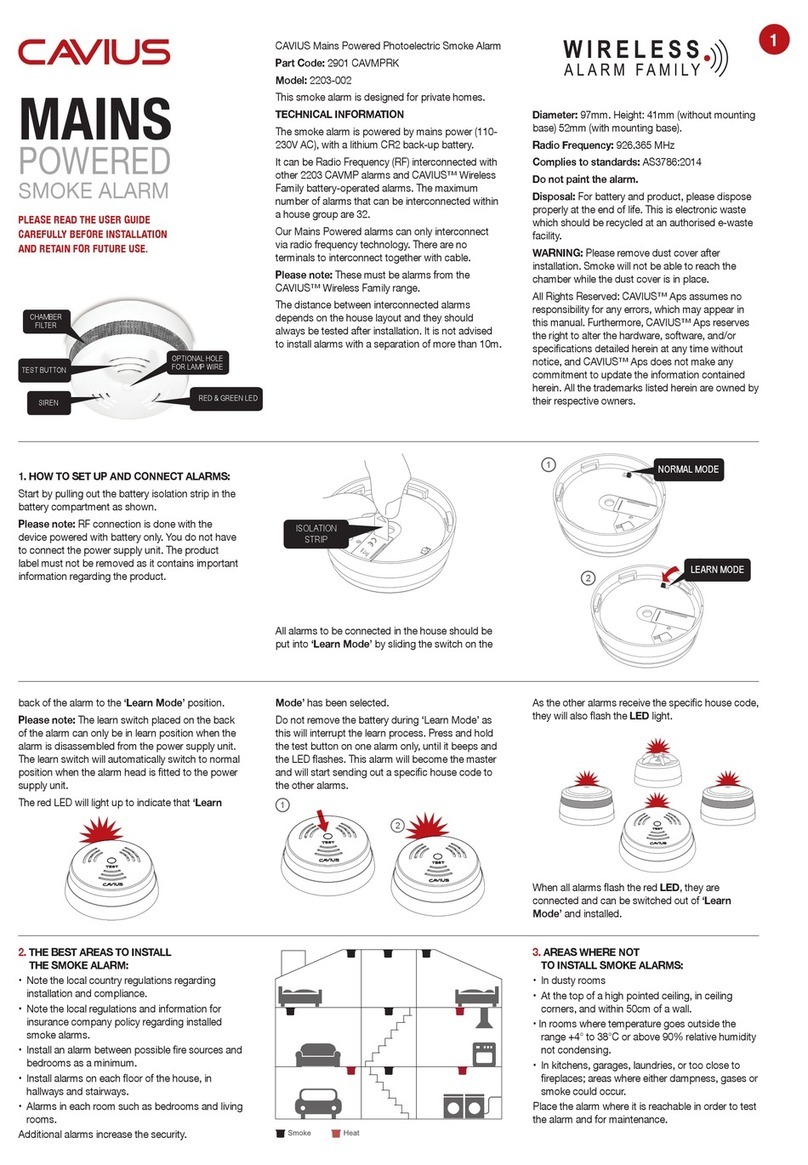MGC SD-100 Series User manual

LT-1055 rev 3 12/14/22
1
25 Interchange way, Vaughan Ontario. L4K 5W3
Phone: 905.660.4655; Fax: 905.660.4113
Web: www.mircomgroup.com
GENERAL DESCRIPTION
• Model SD-100-2WT: 2-Wire Photoelectric Smoke Detector with Heat
Sensor and Remote Indicator
• Model SD-100-4WT: 4-Wire Photoelectric Smoke Detector with Heat
Sensor
• Model SD-100-2WP: 2-Wire Photoelectric Smoke Detector with
Remote Indicator
• Model SD-100-4WP: 4-Wire Photoelectric Smoke Detector
All models incorporate a microprocessor with an advanced optical sensing
chamber. Models SD-100-2WT and SD-100-4WT feature a restorable,
fixed temperature (135°F/57.2°C) thermal detector. SD-100 Series
detectors are designed to provide open area protection.
TYPICAL WIRING DIAGRAMS
FIGURE 1: Typical wiring diagram of the 2-wire multiple-station
smoke detector system
FIGURE 2: Typical wiring diagram of the 4-wire multiple-station
smoke detector system
CAUTION: DO NOT USE LOOPED WIRE UNDER TERMINALS 2 AND 5.
BREAK WIRE RUN TO PROVIDE SUPERVISION OF CONNECTIONS.
MISE EN GARDE: POUR LE CONTRÔLE DES SYSTÈMES – POUR
LES BORNES 2 ET 5, NE PAS UTILISER DE FIL ENROULÉ SOUS LES
BORNES. COUPER LE CÂBLAGE POUR ASSURER LA
SURVEILLANCE DES RACCORDEMENTS.
INSTALLING THE BASE
FIGURE 3: Installing 6” base
Notes: The end-of-line devices shown in Figures 1 and 2 must be
compatible with the control panel. The end-of-line supervisory relay must
be rated for the DC power voltage used.
Open area smoke detectors are intended for mounting on a ceiling or a
wall in accordance with the fire standard in your country.
There is a limit of 21 smoke detectors on one loop.
1. Ensure that all wires are properly identified, and fasten the wires
away from the connector terminals.
2. If you used a jumper wire to connect the poles of terminals 2 and 5
when testing the detector loop continuity, remove the jumper wire
before you install the detector head.
3. Mount the base of the smoke detector directly onto an electrical
junction box such as an octagonal (3”, 3.5” or 4”), a round (3”), or a
square (4”) box without using any type of mechanical adapter.
INSTALLING THE HEAD
1. Thoroughly clean the area of construction debris and dust.
2. Align the mark on the detector head with the short mark on the base
and twist the head clockwise to secure it. The mark on the head
should line up with the long mark on the base.
FIGURE 4: Attaching detector head onto base
WARNING
TO PREVENT DETECTOR CONTAMINATION AND SUBSEQUENT WARRANTY
CANCELLATION, THE SMOKE DETECTOR MUST REMAIN COVERED UNTIL
AREA IS CLEAN AND DUST FREE.
AVERTISSEMENT
POUR ÉVITER LA CONTAMINATION DU DÉTECTEUR ET ANNULER LA
GARANTIE, LE DÉTECTEUR DE FUMÉE DOIT RESTER COUVERT TANDIS
QUE L'ENDROIT EST PROPRE ET SANS CONTAMINER DES POUSSIÈRE.
INITIATING
LOOP
UL864
LISTED
COMPATIBLE
CONTROL
PA N EL
+
í
FIRST DETECTOR BASE
LAST DETECTO R BASE
EOL
DEVICE
í
+í
REMOTE
INDICATOR
CLASS A OPTIONA L WIRING
NOTE: IF REMOTE INDICATOR IS NOT USED, REVERSING POLARITY ON DETECTOR IS
PERMITTED.
+
2A
2B
65
4
3
1
2A
2B
65
4
3
1
2A
2B
65
4
3
1
2A
2B
65
4
3
1
INITIATING
LOOP
UL864
LISTED
COMPATIBLE
CONTROL
PAN EL
+
í
FIRST DETECTOR BASE LAST DETECTOR BASE
CLASS A OPTIONAL WIRING
+
POWER
TO
DETECTOR
í
EOL
POWER
SUPERVISION
RELAY
MODULE
END
OF
LINE
DEVICE
PUSH TAB WITH
RAISED PLASTIC
DOT AND TURN
HEAD TO UNLOCK
RECTANGULAR
OPENING HERE
LED DETECTOR HEAD
4” BASE
SHORT ALIGNMENT MARK
LONG ALIGNMENT MARK
RECTANGULAR
OPENING HERE
DETECTOR HEADLED
LONG ALIGNMENT MARK SHORT ALIGNMENT MARK
6” BASE
INSTALLATION AND MAINTENANCE INSTRUCTIONS
SD-100 Series Photoelectric Smoke Detectors

LT-1055 rev 3 12/14/22
2
ALARM AND SMOKE SENSOR TESTING
1. Disengage all the alarm signal services, releasing devices, and
extinguisher systems during testing.
2. Energize the detector head for approximately one minute.
3. Make sure that the LED flashes green once every 5-7 seconds.
If it is not flashing, the detector is not functioning or the wiring is
faulty. Re-check the wiring or replace the detector if necessary.
4. Position the test magnet against the side of the detector opposite the
side marked DO NOT PAINT for at least 10 seconds.
The LED should illuminate steady red.
5. Reset the control panel to return to normal operation.
6. Allow smoke from a cotton wick or a test smoke aerosol to enter the
detector-sensing chamber for at least 10 seconds.
When sufficient smoke has entered the chamber, the LED illuminates
steady red. If it does not, then the detector requires service.
7. Reset each detector and control panel before testing any additional
detectors in the same zone.
8. Re-engage all the alarm signal services, releasing devices, and
extinguisher systems immediately after testing.
HEAT SENSOR TESTING (SD-100-2WT and SD-100-2WT)
1. Switch on a flow of hot air at a temperature between 65°C and 80°C.
This requirement can be met by some domestic hair dryers. Check
that the temperature is correct and stable.
2. From a distance of several inches, direct the airflow at the guard
protecting the thermistor. The detector should sound its alarm within
30 seconds.
FIGURE 5: Heat sensor testing
3. When the alarm sounds, immediately remove the heat source and
check that the LED is illuminated red.
4. Reset the detector from the control panel.
If the detector fails to sound its alarm within 30 seconds, it is too
insensitive. Return it to the distributor for servicing.
5. Check that the system is set for normal operation and notify the
appropriate authorities that the testing operation is complete and the
system is active again.
NOT SUITABLE FOR INSTALLATION IN AREAS WHERE AIR
VELOCITIES EXCEED 300 ft./min.
MAINTENANCE
The recommended minimum requirement for detector maintenance
consists of an annual cleaning of dust from the detector head by using a
vacuum cleaner. All maintenance operations must comply with NFPA-72A
standards.
CAUTION: DO NOT ATTEMPT DISASSEMBLY OF THE FACTORY
SEALED SMOKE DETECTOR. THIS ASSEMBLY IS SEALED FOR
YOUR PROTECTION AND IS NOT INTENDED TO BE OPENED FOR
SERVICING BY USERS. OPENING THE DETECTOR HEAD WILL VOID
THE WARRANTY.
ATTENTION: NE PAS DEMONTRER LE DÉTECTEUR DE FUMÉE. CET
ENSEMBLE EST ÉTANCHE POUR VOUS VOUS PROTEGER
CONTRE LES ELEMENTS ET N'EST PAS PREVUE DE L'OUVRIR
POUR L'ENTRETENIR. EN OUVRANT LA TÊTE DE SONDE
ANNULERAIT LA GARANTIE RESPECTIVEMENT.
FOR MORE INFORMATION, REFER TO THE TECHNICAL BULLETIN
LT-5267 SD-100-2W/4W.
DIRECT AIRFLOW HERE
SPECIFICATIONS
Accessories: RSR-100 Remote Sensitivity Meter for SD-100 Detectors (LT-1146)
WARRANTY
Purchase of all Mircom products is governed by:
https://www.mircom.com/product-warranty
https://www.mircom.com/purchase-terms-and-conditions
https://www.mircom.com/software-license-terms-and-conditions
Model 2/4 wire Thermal Voltage
DC
Standby
Current
(Max.)
Alarm
Current
(Max.)
Surge
Current
(Max.)
Start-Up
Time
(Max.)
Permissible
Current
(Max.)
Frequency Alarm contact Base model
SD-100-2WP 2 - 12.0~28.0V 140μA 90mA 200μA 60 Seconds 90mA 5-7 Seconds — SDB-106-4 or
SDB-104-4
SD-100-2WT 2 57.2 °C 12.0~28.0V 140μA 90mA 200μA 60 Seconds 90mA 5-7 Seconds — SDB-106-4 or
SDB-104-4
SD-100-4WP 4 - 10.5~33.0V 140μA 48mA 200μA 60 Seconds 48mA 5-7 Seconds Form A SDB-106-4 or
SDB-104-4
SD-100-4WT 4 57.2 °C 10.5~33.0V 140μA 48mA 200μA 60 Seconds 48mA 5-7 Seconds Form A SDB-106-4 or
SDB-104-4
This manual suits for next models
4
Other MGC Smoke Alarm manuals


